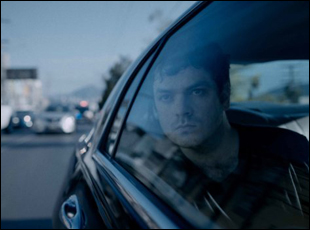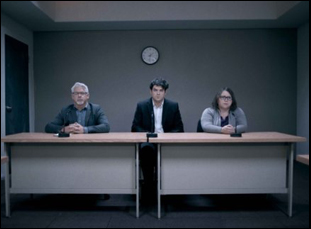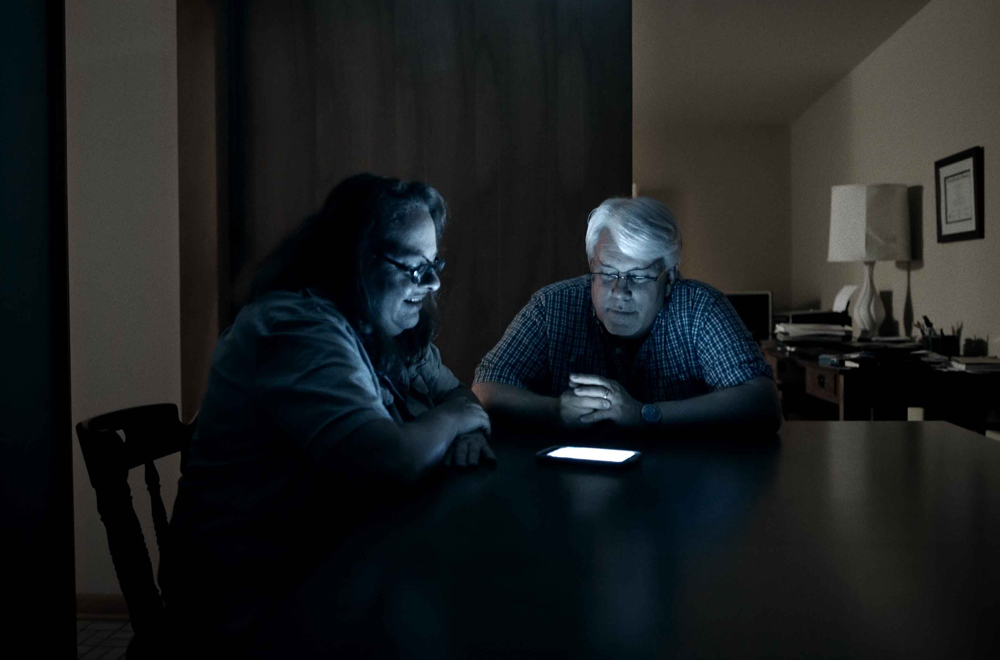After making her arresting debut feature “National Bird,” Sonia Kennebeck had mentioned a desire to try her hand at fiction films some time soon, but in a world where the lines have increasingly blurred, there has simply been no need to stray from her roots as a journalist to find stories with unbelievable twists and turns. In fact, Kennebeck recently completed work on not one but two such films that have been the talk of the festival circuit in recent months, debuting at SXSW “United States vs. Reality Winner,” a chronicle of the whistleblower’s increasingly outrageous prison sentence for leaking documents as an NSA subcontractor that demonstrated Russian interference in the 2016 U.S. presidential election, and “Enemies of the State,” an alternately riveting and troubling look at the case of Matt DeHart, a former member of the Air National Guard who finds himself caught up in charges of soliciting sexually explicit pictures of a minor when it’s revealed he may have been privy to sensitive and concerning information about American drone operations in foreign countries, that’s now arriving in theaters after premiering as part of the Toronto Film Festival last fall.
With DeHart now behind bars, only his parents Paul and Leann are around to defend him, going so far as to seek out political asylum in Canada when they come to believe the FBI and CIA are conspiring against them and Kennebeck untangles the wild story of their bid to break free, uniquely suited to tell a story in which it’s likely no one is telling the whole truth but everyone holds at least a piece of it. A rare filmmaker in her consideration of the big picture, not only as far as her far-reaching investigations, but in terms of how she presents them, Kennebeck has burrowed deeper with each successive film to give shape to U.S. foreign policy that is largely shrouded in mystery as those who have enlisted to work on their behalf find themselves coming to question what their efforts are actually for.
While the situations she dives into are always murky, Kennebeck finds ways to convey them clearly, incorporating haunting shots from the sky in “National Bird” to accompany warnings of how American drones peppered Afghanistan with bomb blasts that likely were unconcerned with civilian casualties, and now peeking behind closed doors in “Enemies of the State,” following career bureaucrats at federal offices wander through endless hallways where cases like DeHart’s can be stuck in endless limbo and without any consistently reliable sources to tell the story, the director ingeniously takes testimony offered during DeHart’s court appearances and puts it in the mouths of actors, using lip-synced recordings to convey a reality where even when a person is speaking their truth, it has to be considered in a grander context. Although DeHart’s case has sparked considerable speculation both as to his own motives and those of the government, Kennebeck manages to walk the fine line of not giving preference to either, instead demonstrating how the seeds of doubt planted by both sides are allowed to persist and distract from actually revealing the truth of the matter when it could be damaging to all.
Kennebeck’s ability to bring receipts is extraordinary at a time when both distrust in institutions and the weight given to the most specious of conspiracies seem to be at an all-time high and being able to sound alarms without ever sounding alarmist, the filmmaker has been a bright light, able to illuminate some of the darkest corners governing the world, and with the release of “Enemies of the State,” she spoke about how she’s been able to build such a compelling body of work, finding a symbiosis of fact-based storytelling and reconstructing what she can with her camera, and demanding greater accountability of public officials.

For me, they do because on the surface, they have quite different styles. I work with the same creative team [on all of them] – my cinematographer Torsten Lapp, I’ve worked with him for over 15 years. My editor Maxine Goedicke edited all the three feature films, my producing partner Ines Hoffman Kanna has been doing the research with me, and then we’re working with the same composer Insa Rudolph, so of course informs our knowledge base. We don’t want to repeat ourselves, but thematically, the films do intersect, and I was in production on “National Bird” when I actually heard the Matt DeHart case. We were working with these other drone whistleblowers and I really understood the paranoia at the core of that story, but back then “National Bird” was so research intensive, I couldn’t dive into another research-intensive story, but it just stuck with me. When “National Bird” was released, I always circled back to the Matt DeHart story because it had a connection to my previous work, and “Reality Winner” is very closely connected to “National Bird,” so I see a lot of connections and there are actually parts where it is drawing a direct line to some of our previous work.
In “National Bird,” you were careful to label recreations as such, and obviously, the aesthetic here mirrors the experience of such a murky situation. Did you have to get over anything in your own mind about blurring reality and fiction in how to tell this story?
My team and I don’t really work in a set structure, and the way we approach a story from the very beginning, I have the first idea and I actually sit down with them, like, “Hey, this is the story, I’m thinking to use recreations [for example]” and then from there, in conversations, we develop this style of the film. It’s very individual [to the specific subject]. In “Reality Winner,” it’s very much based on Reality Winner’s humor and her diary entries and “National Bird” was really driven by the characters and of course these aerial visuals and this feeling of surveillance [of] how it could feel like to live under drones. In “Enemies of the State,” it’s very intentionally structured in the sense that you get to know the family first and the story that they had been sharing in public through the Courage Foundation and social media because that’s what we encountered first, then it took a really long time to get the investigator and the prosecutor in front of the camera and they opened up an entirely different perspective.
For the clarity of the story, it was really important to set the stage in a sense and I did use court records and everything I could find to recreate it as factually as possible with everything we could find, but there’s still of course there’s the element of Matt telling his own story. Sometimes he’s the only person that could describe some of these events and it was important to get into the hearing room in Canada because that’s where we had the original audio. It was Matt’s own voice retelling his own story, so it was clear we had to use it and it is a red line basically because he tells his story from the beginning – his perspective – and then because it’s not a podcast but a film, the recreations became the method, but also for me, it was always this layer [where] his testimony was like his stage in Canada, so recreating that does have a second layer and a meaning.
Every one in this film has an agenda and their own truth, so what was important to me was that everyone who would participate could share their perspectives. We also tried to include the victims’ families through their testimonies in court in Tennessee, and the form of the recreations informed the ambiguity of the story. It is hard to separate what is a person’s take on the story and what is the truth, so there are the interviews with all the protagonists and then the documents, which are very important, and then the recreation or the retelling, and [at that point] I actually recreated a level that you won’t even see onscreen.
Is there something that you could hold onto as your own truth when there were all these different and contradictory perspectives?
When we started doing all these interviews, it became clear quickly [from] talking to more and more people and getting them in front of the camera that some of their statements were entirely contradictory. At that point, you as a journalist or as a filmmaker are struggling with these types of testimonies and wondering what is the truth here — or what I’m still wondering is there a certain interpretation of the truth? For me, the film has so many layers about what’s the nature of truth and about human behavior because you see the people speaking out in the film all transport a very strong belief and conviction, so what my producing partner Ines Hoffman Kanna and I were really hanging onto [were] every document and tangible piece of evidence we could find. That’s where we invested a lot of time, doing a lot of public records and Freedom of Information Act requests. Some of the documents that the attorney discusses towards the end of the film, we filed a motion to unseal documents and a judge did that, so that’s how we got access to more documents and we read and went through the court records over and over again. That’s really what we were hanging onto — the paperwork, cross referencing everything people said.

While we were investigating the story, all these conspiracies were circling and there were so many lies and misinformation being spread at the same time, I always felt this film would be about more just this one single case, and when I watch the film, I really see all these layers of research and trying to confirm information. What I really want people to take away from it is to understand the value of research, investigative journalism and critical thinking. I don’t want to serve them my narrative and I definitely did not want to start speculating. A lot of the story is filled with ambiguity and our world – and human behavior — is filled with ambiguity, and I think some people are feeling uncomfortable with that, but this is really part of our life, and when you have secrecy, especially government secrecy, you shouldn’t be filling these gaps with speculation. Sometimes you just have to deal with it. You might have to research more and push more.
In terms of verifiable information, what has been frustrating me with all of my films is that it’s so difficult to get government agencies, prosecutors, U.S. attorneys, U.S. government officials and politicians on the record and in front of a camera. The FBI has a press department and I strongly believe as a journalist that all these agencies should be transparent to the public. It’s crucial in a democracy and with “National Bird” and the military, you do requests and sometimes they ghost you or straight up deny, but sometimes they just don’t respond to you when you do official requests. I find that highly problematic and especially on “Enemies of the State,” you see part of the problem in this case is that the FBI has been so untransparent. They’re still documents that are secret. They sent us an e-mail saying no current or former employee should provide assistance for this project, and I don’t think that should be an answer to a journalistic team. [There should] at least be an explanation, which there wasn’t.
Was it a different experience making a film that may have been happening more in the moment than your other films? Those seemed like open cases as well, but the main event seems to have already happened and you’re reflecting on it.
It was, and it was an extraordinary experience for our entire team. We’re still discussing it over and over because we really went into the research of this film very open-minded and we didn’t know the outcome of it. [This film] really follows the journey of our investigation and what’s very important when you do these investigative type of films is that I really don’t think you should go into a documentary film planning and scripting everything because then you go in with blindfolds, especially any story that has multiple perspectives. You should be really be open to where the investigation and the story takes you, and that was very challenging, but it was really important for me to take the audience on that same journey, so they understand the process of what we were going through.
“Enemies of the State” opens on July 30th in New York at the IFC Center and Los Angeles at the Encino Town Center, the Pasadena Playhouse and the Royal.




